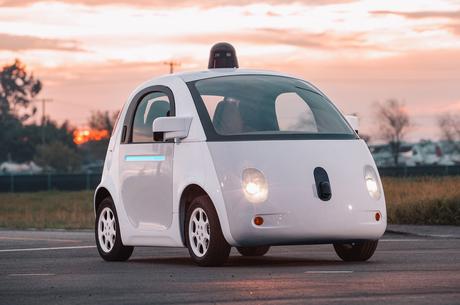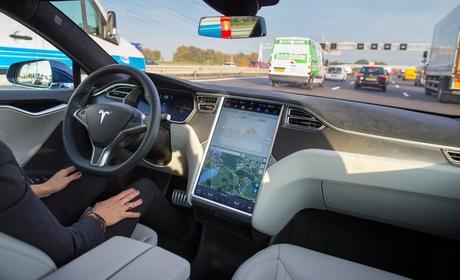
Well, something is bound to happen soon with self-driving cars. Not only has Google just hired Airbnb executive Shaun Stewart, Uber is getting more and more serious about introducing self-driving cars to their fleet. In the past week, self-driving Uber cars have been spotted around Pittsburgh.
Self-driving cars either sound great idea or a terrible one, depending on whether you're currently wishing desperately that you could just pass out during your commute or if you've just watched your smart phone turn itself off in some sort of programming overload related tantrum. But, like it or not, something that's been in the public consciousness this long is bound to turn up in the real world eventually.
But has it been in the public consciousness that long? Was Kit in Knight Rider self-driving? Were stories about haunted cars commonplace before Stephen King's Christine?
A Long Imagination
As it turns out, autonomous vehicles have been experimented with since the Jazz Age, or the 1920s. In 1925, a driverless car was unleashed on the streets of New York during a traffic jam and acquitted itself rather well. The car was a 1926 Chandler, and was operated by remote control. Because of the technological limitations of the day, this remote was located in the car behind it, which did have passengers in it.
This demonstration was repeated, under various names (the original autonomous car was called the "linrrican Wonder") and in various locations, including the 1939 World's Fair. The World's Fair predicted that self-driving cars would largely be guided by external electrical and magnetic systems.
These experiments were reopened, as it were, in the 1950s. Instead of relying on a remote operator, scientists and engineers began searching for way for the car itself to take control.
In 1953, RCA Labs built a miniature automobile that was 'driven' by a series of electronic cables beneath it. These results were so promising that by 1958, RCA Labs had collaborated with the State of Nebraska to recreate this experiment on a human-sized scale. After completing a 400 foot-long strip, which not only included wires buried under the track but also used lights to signal the cars as well, a series of successful experiments took place.
The automatic controls were simulated in collaboration with General Motors, which produced much of the specialized equipment. The results were displayed to reporters in 1960s and reported by the New York Times. General Motors initially believed that self-driving cars would be on the market by 1975. Needless to say, they were not.
Throughout the 1960's, various labs all over the world attempted to produce a cheap means of producing and supplying the equipment needed to produce the roads that allowed the autonomous vehicles to operate. By 1970, scientists had come to the conclusion that the driving system needed to be located in the car itself; over the course of the next two decades, scientists attempted to do just that.
While the initial research was conducted in the early 1970s at the University of Illinois' Coordinated Science Laboratory, a 1980s team at Bundeswehr University Munich, lead by Ernst Dickmanns, produced a robotic van, which achieved speeds of almost 39 miles per hour on an empty street.
By 1989, Carnegie Mellon University was using neural networks to guide autonomous cars. Since then, greater and greater feats of engineering have been accomplished, including the integrating of this technology into public transportation around Europe.
Currently, most major automobile manufacturers are researching and developing self-driving cars, and have been for the past few years. Google even began doing so in 2009, years before admitting the project publicly.
A potentially volatile dream
There are, of course, going to be problems with self-driving cars; there are always unanticipated problems. A driver died earlier this summer while his Tesla's Autopilot mode was engaged; it failed to identify a white truck on a bright day and the distracted driver suffered a fatal collision. Even with improvements in automated function and autonomous driving strategies, mistakes are still going to happen.

This new frontier for mistakes is going to have a particularly interesting effect on Uber's business model. Uber, thus far, has largely avoided public scrutiny by providing a middleman service, and thus escaping liability for damages caused by the app, including women being stalked and harassed by men they encountered through using it. Or it may not: using self-driving cars almost certainly means that Uber will be updating its terms of service and, most importantly, their arbitration clause.
This arbitration clause might not even be the most legally worrying thing about introducing self-driving cars into the general population. The Digital Millennium Copyright Act would almost certainly protect the programs and neural networks used to drive the cars. This law, protecting intellectual property, allows businesses that sell computers, computer programs and electronic devices to assert that they are not necessarily just selling the products themselves but are primarily selling the right to use those programs and products.
One of the more famous examples of this conflict involves e-readers, such as the Amazon Kindle. There are more than a few reports of numbers of books, from a single text to the entire electronic library, being removed from Kindle e-readers without warning or explanation, because when a person purchases an electronic text, what they are actually purchasing is the right to use the software that contains the text. The same general principle applies to apps like Uber.
The logical next step for autonomous vehicles is the incorporation of this type of language into the sales contracts. The programming for automatic driving definitely falls under this type of intellectual property law. We all learned from John Oliver's Last Week Tonight that car repossession can take the form of a small, beeping device in your car that shuts off the ability to start if you get too far behind on your car payments.
Imagine that level of inconvenience operating at a level where being locked out of your operating system can happen without any explanation. If that's frustrating with e-books or music, imagine being locked out of your car because your ability to use its internal computer has been revoked. Now that's harsh.

